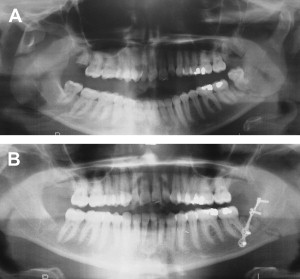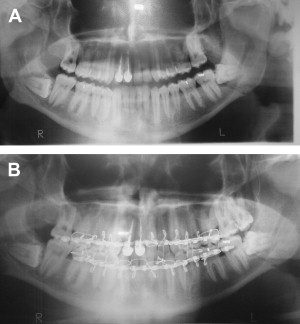Many mandibular fractures occur through tooth sockets. The treatment plan for teeth in the line of fracture has evolved through the years because of the development of new antibiotics and fixation techniques. In this article we review the history and current studies and discuss treatment protocols for teeth in the line of mandibular fractures.
Many mandibular fractures occur through tooth sockets. The treatment plan for teeth in the line of fracture has evolved through the years because of the development of new antibiotics and fixation techniques. In this article we review the history and current studies and discuss treatment protocols for teeth in the line of mandibular fractures.
History
Opinions differ regarding removal of teeth in the line of mandibular fractures. In 1975, Canaro agreed with Kruger, Archer, and Rowe that each case should be decided on its own merit; however, Clark, Ivy, and Thoma recommended the removal of teeth within a fracture line . Proponents for removal of teeth adjacent to a fracture line believe that these teeth can potentially become a source of infection and be detrimental to a successful outcome of mandibular fracture treatment. Many surgeons hold the opinion that the only complication with leaving these teeth is infection; however, many of the teeth can be retained with the proper use of antibiotic therapy . Canaro described the prophylactic removal of teeth leading to other problems, including allowing greater communication of the fracture site with the oral cavity and further distraction of the fracture segments ( Fig. 1 A ). Extraction of these teeth also could lead to secondary displacement of the fractures, problems with immobilization of fragments, and the need for intraosseous fixation. Canaro’s reason, along with the opinions of other surgeons, for maintaining these teeth is that they may allow easier methods of treatment. This would avoid the need for an open reduction and the potential complications associated with this surgery.

Many surgeons agree that teeth that are hopelessly mobile or fractured or complicate the reduction of the fracture should be removed ( Fig. 1 B). Canero believes that if certain conditions are met, teeth in the line of fracture can be preserved. The conditions for maintaining teeth in the line of fractures include maintaining antibiotic therapy, strict oral hygiene, radiologic and clinical monitoring for evidence of periapical infection and pulp necrosis, and endodontic therapy for teeth that require treatment ( Fig. 2 A , B) . De Amaratunga stated that teeth in the line of fracture could be salvaged if proper fixation techniques were used along with antibiotic coverage .

Review of current studies
In 2000, Spina and Marciani listed the following pitfalls in making decisions regarding leaving teeth in the line of fracture : (1) not treating teeth with pulpal involvement or periapical pathology, (2) maintaining teeth that can become symptomatic and necrotic and can infect the fracture site, and (3) routinely extracting teeth in the fracture line to reduce fracture repair morbidity. They advocated considering the retention of teeth with a guarded prognosis if they are useful for reduction or stabilization of the fracture ( Fig. 3 A , B). Ellis found virtually no difference in the incidence of infection when teeth were left in the line of fracture or extracted . Similar conclusions were made by Chuong and colleagues during their studies.




